Exploring Mykonos Architecture
Mykonos, a vibrant island of the Cyclades, is known for its stunning architecture that tells tales of history,
luxury, and innovation. Journey through the various architectural styles as we explore the historical evolution
of Mykonos villas, from humble fishermen’s huts to opulent villas, tackling piracy and catering to the elite
over centuries. Drift through the tales of kinglike villas unique to Mykonos, some turned into museums. Learn
how architecture is a pillar in Mykonos’ hospitality industry and discover the architects who have left their
mark. Embrace eco-friendliness and sustainability in contemporary designs, blending with the island’s artistic
landscapes. Finally, witness how Mykonos architecture receives a modern facelift while staying rooted in its
rich history. In our next steps, we’ll summarize our exploration, providing a comprehensive guide to Mykonos
architecture.
Historical Evolution of Villas
From fishermen’s huts to tourist havens
The architecture of Mykonos has evolved significantly over the centuries, reflecting its transition from a
small fishing community to a renowned tourist destination. Originally, the island’s structures were simple
fishermen’s huts crafted from readily available materials like stone and wood. These modest constructions
were designed to withstand the island’s harsh climatic conditions, with their thick walls offering
insulation against both the heat of summer and the cold of winter.
As tourism began to flourish in the 20th century, these simple huts evolved into more sophisticated
properties. The necessity for comfort and modern amenities saw traditional structures adapt to become
the luxurious villas that attract global travelers today. This architectural transformation laid the
groundwork for Mykonos as a key player in the hospitality sector, with an irresistible blend of rustic
charm and contemporary comfort.
Preventive measures against piracy
During the height of piracy in the Aegean Sea, Mykonos’ architecture took on defensive characteristics.
The islanders constructed their homes with strategic considerations in mind, such as ensuring limited
visibility from the sea and incorporating labyrinthine pathways around residential areas.
Buildings were often clustered together to create a protective barrier, with narrow, winding streets
that complicated pirate raids. This defensive architecture is still visible in places like Mykonos
Town, where tight-knit structures and narrow alleys not only serve historical purposes but also offer
a unique aesthetic that attracts modern visitors.
The first lavish mansions & their famous residents
In time, Mykonos became a magnet for wealthy merchants and influential figures who left their mark on
the architectural landscape by constructing luxurious mansions. These villas showcased sophisticated
design and superior craftsmanship, highlighting the social status and wealth of their owners.
Famous residents throughout history have included captains and traders who contributed significantly
to the island’s economy. These affluent individuals not only financed the construction of these grand
homes but also influenced their design, leaving a legacy of architectural opulence that still draws visitors
today.
Kinglike Villas – Setting the Standards in Luxury Villa Stays
Mykonos is synonymous with luxury, and its kinglike villas are the epitome of opulence. These
properties set the standard for luxury villa stays, boasting architectural designs that marry
tradition with modernity. Featuring expansive views, infinity pools, and personalized services,
these villas transform a stay in Mykonos into an unforgettable experience.
Offering exclusivity and privacy, these villas cater to the affluent and the elite, providing a retreat
where comfort and extravagance coexist harmoniously. The architecture of these villas integrates
seamlessly with the surrounding landscape, making them a crucial attraction on the island.
Notable Villas Turned Museums or Landmarks
Some of Mykonos’ most historic villas have been transformed into museums or preserved as landmarks,
offering a glimpse into the island’s rich cultural past. These iconic structures serve as windows into
the lives of those who once inhabited them and now stand as proud testaments to timeless
architectural styles.
A notable example is the Lena’s House, a traditional 19th-century Mykonian mansion that has been turned
into a museum. Such restorations not only protect architectural heritage but also educate visitors about the
island’s fascinating history and the stylistic influences that have shaped its unique identity.
The Importance of Architecture in Mykonos’ Hospitality Industry
Architecture plays a pivotal role in Mykonos’ booming hospitality industry. The design and aesthetics
of villas and hotels directly influence the island’s appeal as a global vacation destination, drawing
travelers with a penchant for beauty and sophistication.
The hospitality industry has capitalized on Mykonos’ architectural allure by blending modern amenities
with traditional Cycladic design elements. This combination creates a unique selling point that enhances
the island’s reputation as a must-visit luxury destination.
Architects Influencing the Design and Style of Mykonos Villas
Several visionary architects have left their mark on Mykonos, crafting villas that epitomize modern
Cycladic architecture while maintaining the island’s historical roots. These architects weave innovation
with local traditions, creating spaces that are both functional and aesthetically pleasing.
Influences from notable architects are visible in the seamless integration of indoor and outdoor spaces,
allowing for open-air living while respecting the need for privacy and seclusion. Their dedication to
sustainability and harmony with the environment helps preserve Mykonos’ natural beauty for future
generations.
Eco-Friendliness at its Best
In Mykonos, eco-friendly architecture has become a priority in villa design, addressing the increasing
demands for sustainable living environments. Many properties have adopted green-building practices,
incorporating energy-efficient systems, solar panels, and sustainable materials into their designs.
These eco-friendly initiatives not only minimize the environmental impact but also enhance the island’s
natural charm. A commitment to sustainability ensures that Mykonos remains a pristine paradise,
attracting environmentally conscious travelers.
Inspiring Landscape & Artistic Uniqueness
Mykonos’ architecture is intricately connected to its breathtaking landscape, drawing inspiration from
the undulating hills, azure waters, and barren rocks. This landscape offers architects a rich canvas,
prompting creativity and innovative design.
Artistic uniqueness is apparent in the variety of structures, where each villa is tailored to accentuate
its surroundings. The distinctive shapes and harmonious colors reflect the island’s spirit and its
commitment to preserving the aesthetic beauty amid modern developments.
Today’s Facelift
The architectural scene in Mykonos continues to evolve with fresh facelifts that adhere to the island’s
classic aesthetic while embracing contemporary trends. This careful balance ensures that new developments
complement rather than overpower the existing landscape.
Renovations and new constructions are mindful of Mykonos’ architectural heritage, ensuring that every
change adds to its cultural storyline. Today’s architects are tasked with maintaining the tradition of
exquisite design while pushing the boundaries of innovation.
Final Thoughts
As we’ve explored, Mykonos architecture is an intricate blend of history, luxury, and sustainability.
From its humble beginnings to its modern-day magnificence, Mykonos villas embody a world of beauty and
significance on the island. The preservation of architectural heritage alongside innovative design continues
to shape Mykonos’ landscape and its allure to global travelers.
In the table below, we summarize the rich architecture of Mykonos, covering historical evolution, luxury
villa standards, notable conversions, and the vital role architecture plays in the island’s identity and
sustainability efforts.
| Aspect | Description |
|---|---|
| Historical Evolution of Villas | From fishermen’s huts to luxurious tourist villas, incorporating defensive measures against piracy. |
| Kinglike Villas | Luxury villas setting high standards in comfort, privacy, and integration with the landscape. |
| Notable Villas | Historic villas turned museums and landmarks, preserving the architectural heritage. |
| Architecture in Hospitality | Influence on tourism and hospitality, combining Cycladic style with modern amenities. |
| Architects’ Influence | Visionary architects who innovate while preserving Mykonos’ architectural roots. |
| Eco-Friendliness | Emphasis on sustainable building practices and minimal environmental impact. |
| Landscape & Uniqueness | Integration with the island’s natural beauty, artistic uniqueness reflecting Mykonos’ spirit. |
| Today’s Facelift | Modern updates respecting historical aesthetics and enhancing architectural heritage. |


